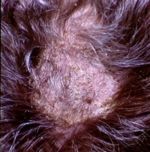| Question |
Answer |
Article |
| What are dermatophytes also known as?
|
- Fungi Imperfecti
- Phaeohyphomycetes
- (Commonly called 'ringworm' in practice)
|
|
Link to Article |
| Which two species of dermatophytes are of particular veterinary interest?
|
|
|
Link to Article |
| Why are dermatophytes usually found in the subcutaneous and cutaneous tissue?
|
- Lack of tolerance to body temperature and antifungal activity in serum and body fluids
- Are able to penetrate all layers of skin however
- Dermatophytosis
|
|
[[|Link to Article]] |
| What clincial signs are usually present with a dermatophyte infection?
|
- Epidermal hyperplasia and inflammation leading to peripheral red 'ringworm'
- Superficial perivascular dermatitis leading to intracorneal microabscesses
- Furunculosis
- Pustules in hair follicles cause by secondary invaders leading to alopecia
|
|
Link to Article |
| How would you diagnose a dermatophyte infection?
|
- Clinical sings
- Wood's Lamp
- Examine in 10-20% KOH for the presence of hyphae or arthrospores with Lactophenol Cotton Blue to enhance visualisation
- Sabouraud's Dextrose agar containing cyclohexamide and chloramphenicol at room temperature for a month for culture
- Culture with Dermatophyte Test Medium (Saubouraud's Dextrose agar with phenol red indicator- medium changes from yellow to red if fungi present)
|
|
Link to Article |
| How are dermatophytes infections treated?
|
- Isolation
- Griseofulvin
- Whitfield's ointment (Salicylic and benzoic acid)
- Aqueous lime sulphur topically for dogs
- Iodine
- Antibiotics
- Natamycin antifungal
- Imidiazole derivatives
|
|
Link to Article |
